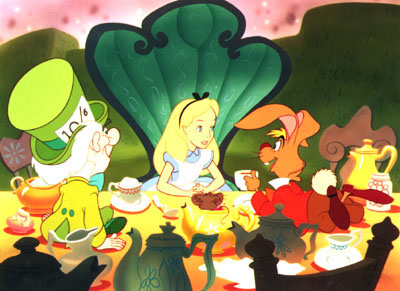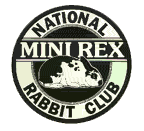

We got our start in 1993 when we joined a local 4-H club. We had no idea what our project would be but when the leader said the club needed a new Rabbit Leader my daughter stuck my hand up in the air and next thing I knew I was going to teach others how to raise rabbits. We had a nice 4 stall horse barn and had 2 empty stalls and began putting cages in the empty stalls. Soon the horses had to stay outside as the bunnies filled all the stalls and then the runway. Soon we were fencing in the barn and stacking our cages to use space efficenty. I began showing at Fairs and small shows and learned about ARBA ( www.arba.net) . At that time we had Standard Rex and Tans. I saw my first mini rex in 1994 and knew I had to have them. We bought the bulk of our mini rex from Anne Lassen, of Ye Wee Rabbitry. We had our best year in Youth in 1996-97 with the purchase of Ye Wee's Abe, Isis, Cara and Howdy. ABE won over 7 Best in Shows in February of 1996 winning a Best in Show EVERY weekend for 4 weeks straight. Ye Wee's Isis placed 2nd in the Sr. Castor Doe class at Mini Rex Nationals in 1997 and produced NIK who produced Top Gun and Niki . We also raised a Tan doe that had a super run with 14 legs and several Best in Shows. We won BOSB at Tan Nationals in 1997!!! We won over 30 Best in Shows/Reserve in Shows while showing in Youth!
In 1999 my children abandoned ship and my husband decided to join forces with me as he and my son had outgrown Little League. He encouraged me to buy better stock- we had good stock but had a few holes here and there that needed plugging with better bucks and brood does. I especially loved the broken castors and wanted better stock in that variety. Anne Lassen told me of a breeder named Connie Williams who was selling out because she had moved to Colorado and then I found out Gerry Westgard was also selling out. In a short time we had 20 new rabbits and decided to sell the Tans to make room and just concentrate on Mini Rex. We didn't show much in 2001 but won BOB almost every time we did show! We knew our new stock had helped as well as the line breeding with our existing rabbits. Gerry Westgard gave me an hour phone lesson on line breeding and its working!!! I may write out what he told me and post it on this web site but if you follow the guidelines in the ARBA Guidebook its pretty much the same. Gerry told me with line breeding he won BOB at the Nationals in only 7 years whereas other breeders had spent 20 years and never even won a BIS. He said treat it like a business and map out your breedings. So I did that using a new notebook wherein every doe has listed on HER page who she can be linebred with. Then when I'm ready to rebreed her I pull out her chart and use only those bucks! Sons, Sires, 1/2 brothers, Uncles, grandsons are all good.
In the beginning, it took me a long time to know the difference between a good and bad mini. I remember a top breeder telling me I needed more depth in my rabbits and it took me a while of puzzeling over what depth was to realize what she meant. Depth is depth of the body from the bottom of the stomach to the top of the back and its about balance. The top of the back should be the highest point on the rabbit. Pose your mini rex and hold a pencil in a verticle fashion on his hipbone. Does the highest point of the back happen at the tip of that pencil? Is the back higher than the ears? Are the ears shorter than its head? Push the ear forward and see if its shorter or longer than the rabbits nose? Long ears mean long body! Do the shoulders rise up right out of its neck? Think bowling ball with head stuck on it!
Then I had to puzzle over peanuts and BUDS- peanuts are a result of the dwarfing gene when Standard Rex were crossed with Netherland Dwarfs to get mini rex. If you don't have peanuts in your litters your rabbit may not have the dwarfing gene and could be a BUD- or big ugly doe (although they aren't all ugly by any means) I have used them with some success as they seem to have great type and depth. Crossed to a SMALL buck they can produce great babies. Harli, my BOV doe is out of a rather large broken black doe with longish ears. Daisy has never been shown but is out of a long line of bunnies I kept breeding and breeding over the course of 5 years or more- they weren't bad enough to cull but I didn't really get anywhere with them- it took breeding Daisy to a beautiful small black GAN buck to get HARLI. Another time I crossed a big broken black doe to a small beautiful (almost perfect) broken opal buck and got a gorgeous grand champion white doe, named QTPIE!
I have almost phased out of BUDS but you know they can pop up in a litter just as often as the peanuts can- it will take several more generations to get the dwarf and standard size genes out of this fairly new breed, the Mini Rex.
Mona Berryhill began working on the Mini Rex breed when she won a pari of DWARF REX donated by Marylouise Cowan at the 61st ARBA Convention in Orlando. The little buck, ZORO, survived and together with a Lynx rex doe named Cotton produced a litter of 7. The 3 does in this litter were kept as the foundation stock for the Mini Rex breed. Anyone with Happy, Bashful and Dopey in their pedigree can trace them back to this beginning. Happy and Bashful went to Linda Thompson and Gloria Middleton is Sarasota, Florida. Meanwhile back in Columbus Mona Berryhill presented the castor mini rex and... the Standards Committee took a look at the animals and approved the working standard for the first year in 1986. There were cheers and tears and predictions that Mini Rex were the fancy of the 90's. Could that be true?
1987 was a busy year for Mini Rex breeders. New varieties were cropping up in litters all over the country due to the obscure Netherland Dwarf influence of the Dwarf Rex. It was quite a surprise to find Tortoise, Sable and Smoke Pearl that first year. We were all experiment with small Standard Rex and Mini Rex crosses to improved body type and fur. It wasn't long before there were Chinchilla, Seals, Californian, Red, White, Blue, Black, Broken, and chocolate to name a few. Virginia Minden from California dn Bill and Laurie Turner from Arizona volunteered to hel pin the presentation process for new varities.. and the path to Portland and the 64th ARBA Conventnion was clear. This was the second year for the breed and the first showing of l5 new varieties. They were: White, Blue, black, Chin, Seal, Calif, Choc and Beige presented by Virginia Munden. Red presented by Bill and Laurie Turner. Tort and Smoke Pearl prsented by Linda Thompson. opal, Broken and Lynx prsented by Mona Berryhill. Otter and Sable presented by Gloria Middleton. Beige, Smoke Pearl, Sable and Otter failed, all others passed with a working standard for their first showing.
Madison, Wisconsin was the site of the 65th ARBA Conv; the final showing of the Mini Rex as a new breed. If they were accepted the Standards Committee agreed to allow the other varieties presented to be accepted as recognized varieites upon approval of each variety. We did it!! The Mini Rex became an accepted ARBA breed and history was made!! Not all varieties presented were accepted.
Tulsa, OK, the 66th ARBA Conv saw record entries in the Mini Rex Breed. They were loved by many, even hated by a few. Time would tell if this was a breed the public would raise and show. Our future is now wide open. New varieties are being worked on including the blue eyed white and Otter. It takes hard work, devotion and determination to make this happen... and love!!!

